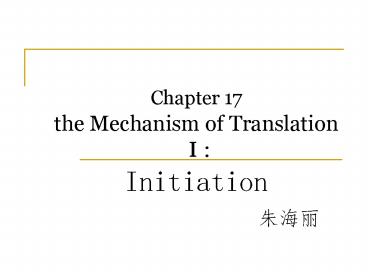Chapter 17 the Mechanism of Translation : Initiation - PowerPoint PPT Presentation
1 / 36
Title:
Chapter 17 the Mechanism of Translation : Initiation
Description:
In 1966 Severo Ochoa and his colleagues isolated the intiation ... IF3 remained attached to free 30S particles, but was utterly absent from intact ribosomes. ... – PowerPoint PPT presentation
Number of Views:115
Avg rating:3.0/5.0
Title: Chapter 17 the Mechanism of Translation : Initiation
1
Chapter 17 the Mechanism of Translation
?Initiation ???
2
contents
- Initiation of Translation in Prokaryotes
- Initiation in Eukaryotes
- Control of initiation
3
Summary of Initiation in Prokaryotes
4
Dissociation of Ribosomes
5
- In 1968,Meselson and colleagues
- Labeled the E.coli ribosomes with heavy isotopes
of nitrogen,carbon and hydrogen
6
(No Transcript)
7
(No Transcript)
8
How this happened?
- In 1966 Severo Ochoa and his colleagues isolated
the intiation factors by washing ribosomes with
buffers of progressively higher salt
concentration. - extracted IF1 and IF2 from ribosomes with a
wash of 0.5M NaCl, and IF3 with a wash of 1.0M
NaCl.
9
- In1970, they used sucrose gradient centrifugation
to measure the relative amounts of ribosomes and
ribosomal subunits in the presence and absence of
IF1 ,IF2. IF3
10
Results
- a highly purified preparation of IF3 could
apparently cause dissociation of 70S ribosomes
into 30S and 50S subunits, - IF1 could not.
- IF2 was also ineffective as a ribosome
dissociation factor.
11
IF3
- Steven Sabol and Ochoa went on to show that IF3
binds to 30S ribosomal particles but does not
remain bound when 30S and 50S particles get
together to form intact ribosomes.
12
- labeled IF3 with 35S,
- use ribosomes from E.coli strain MRE600
- separated ribosomes and subunits by sucrose
gradient centrifugation - the more IF3 added to the ribosomes ,the
more dissociation occurred - They allowed the 30S particles with labeled IF3
attached to combine with 50S particles to form
ribosomes, sucrose gradient centrifugation - IF3 remained attached to free 30S particles,
but was utterly absent from intact ribosomes.
13
IF3 dissociates from 30S particles before they
are incorporated into ribosomes
- Then ,
14
IF1
- They measured
- 1. the rate of dissociation of ribosomes,
- 2. the equilibrium concentrations of intact
ribosomes and ribosomal subunits - (Those concentrations reflect both dissociation
and association rates.)
15
- IF1 actually promotes dissociation, and IF3 binds
to the free 30S subunits and prevents their
reassociation with 50S subunits.
16
Formation of the 30S Initiation Complex
- Include 30S ribosomal subunit mRNA,
aminoacyl-tRNA and initiation factors
17
How to form the aminoacyl tRNA?
amino acid ATP tRNA
aminoacyl-tRNA AMP PPi
18
The First Codon and the First Aminoacyl tRNA
19
- 1.K.A.Marcker and Frederick Sanger tried RNase
digestion the methionyl-tRNA(????), they found
the adenosyl-N-formylmethionine(??????) - 2.B.F.C.Clark and Marcker separated these two
tRNAs by an old preparatory method called
countercurrent distribution(?????).
20
- ??????????????,?????????????????(?????).?
,?????????,????????????????,???????????????,??????
??????????,???????????????????????????????????????
???,?????????,?????????????,??????????????????????
????,??????????????????????
21
- The faster moving tRNA( tRNAmMet)could be charged
with methionine - The slower moving tRNA was tRNAfMet .
22
- They make a labeled aminoacyl-tRNA ,mix it with
ribosomes and a variety of trinucleotides. - tRNAfMet responed to the codon AUG tRNAmMet
responed to the codon AUG,GUG,UUG
23
- They use in vitro translation system with a
synthetic mRNA that had AUG codons scattered
throughout it - When they used tRNAmMet methionines were
incorporated primarily into the interior of the
protein product, tRNAfMet only into the first
position of the polypeptide.
24
Binding fMet-tRNAfMet to the 30S Initiation
Complex
- which initiation factor plays this role for
fMet-tRNAfMet ? - IF2
25
(No Transcript)
26
- IF1 and IF3 together yielded little or no
fMet-tRNAfMet binding , whereas IF2 by itself
could cause significant binding . - all three factoes together yielded optimun
fMet-tRNAfMet .
27
How mRNA bind to the 30S ribosomal subunit
- 1969,Joan Steiz
- E.coli phage R17 (why)
- Small spherical RNA phages(f2 and MS2)
- convenient source of pure mRNA
- Very simple three genes(encode A
protein, coat protein, replicase)
28
- Searched the neighborhoods of the three
initiation codons in phage R17 mRNA - Binding ribosomes to R17 mRNA
- Use RNase A to digest the RNA
- Sequenced the initiation regions protected by
ribosomes
29
- Richard Lodish
- On the translation of the f2 coat mRNA by
ribosomes from different bacteria - E.coli translate all three genes
- Bacillus stearothermophilus only translate the
A protein gene
30
- Nomura
- using R17 phage RNA
- If the 30S subunit came from E.coli the R17 coat
gene could be translated - If it came from B.stearothermophilus ,this gene
could not be translated
31
- dissociated the 30S subunit into its RNA and
protein components - Mixing with other elements to translate
32
- Shine and Lynn Dalgarno
- Look for possible interactions between the 16S
rRNA and sequence around the start sites of the
R17 genes, - They find the sequence is complementary to the
16S rRNA - SD sequence
33
- they compare the sequences of the E.coli and
B.stearothermophilus 16S rRNAs - An even poorer match between the R17 coat
ribosome binding site and the Bacillus 16S rRNA
34
Formation of the 70S Initiation Complex
- For elongation to occur, the 50S ribosomal
subunit must join the 30S initiation complex to
form the 70S initiation complex. - In this process, IF1 IF3 dissociate from the
complex. Then GTP is hydrolyzed to GDP and
phosphate, as IF2 leaves the complex.
35
summary
- Dissociation of the 70S ribosome into 50S and 30S
subunits, - Binding of IF3 to the 30S subunit
- Binding of mRNA and fMet-tRNAfMet to form the 30S
initiation complex. - Binding of the 50S subunit
- Form the 70S initiation complex, ready to begin
elongation.
36
- thanks































